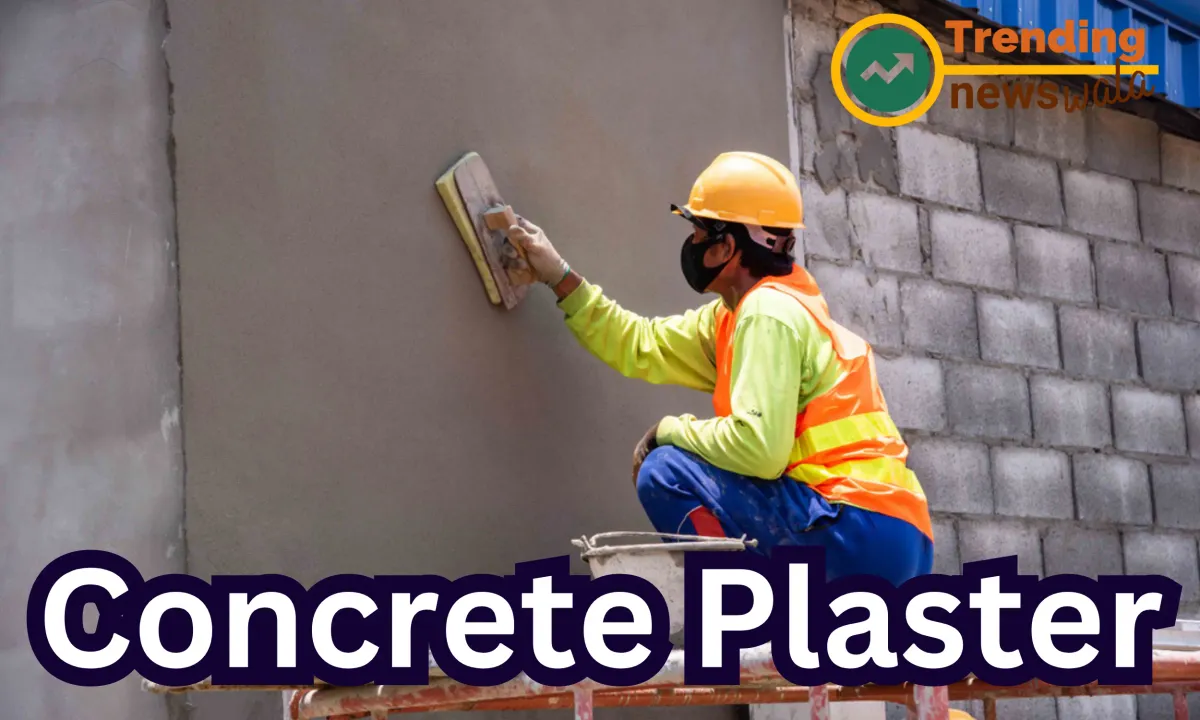Concrete Plaster | How to plaster a wall

How to plaster a wall with concrete? This is the topic of a fundamental completing strategy that is being applied at each building site. Cement Plastering works are the most widely involved completing strategy for the harsh surface of walls or concrete designs. Concrete plaster is the combination of fine sand and concrete which is combined as one with the incorporation of water. This concrete plaster is utilized to spread over the surface that requires a completed surface. Plaster of matches is one more sort of plaster. Nonetheless, in this blog entry, we are covering how to plaster a wall with concrete. Regardless, we should talk about the rundown of instruments.
Rundown of apparatuses
The accompanying devices will be utilized for the extent of work covered under this strategy for proclamation.
- Scoop
- Soul level
- Plum bounce with the line, Ladder
- Plastering Spatula
- Rectangular scoop
- Wood float
- Point float
- Long float
Pre-Plaster planning:
- Clean the surface and eliminate any residue, debased materials on plaster bases and substrates for direct utilization of plaster, eliminating free material and substances that might hinder the work.
- Sand for concrete plastering will be spotless, sieved, and - if vital - washed in consumable water and adjust to Specifications for building sands from regular sources ASTM C144, BS 1198, 1199 and 1200:1976.
- Structure ties and different impediments will be taken out or managed back even with the outer layer of the strong base.
- Introduce impermanent grounds and tirades to guarantee exact rodding of plaster to genuine surfaces. Check the straightness in each corner and add grout to hold the outer corner dabs erroneous and the inward situation to be fixed.
- Prior to plastering begins, hose, by showering water concrete scramble cover surfaces that are to get plaster with clean water.
- The extent of concrete sand and water ought to meet the necessities and be spent inside the predefined time.
- Subsequent to gathering ground mortar, eliminate sundries through screening, add a suitable measure of concrete for blending, and optional use.
- Work out how much material expected by the amount of development; arrange the material into the site by stages. The concrete will be re-assessed as per the arrangements to guarantee that its boundaries meet the prerequisites. Sand should be screened and should contain something like 5% mud.
- The opening in the wall ought to be stopped.
- After the plastering surface layer is done and arrives at a specific strength, splash water for restoring with a sprayer
- The plastering layer will forestall fast drying, water shock, effect, and vibration before buildup, and forestall tainting and harm after buildup
- Control the verticality and levelness of the plastering layer, guarantee that it is solidly joined with the block without void.
- Ensure that the electrical sheets and wiring ought to be fixed under plaster.
- Electrical wires and sheets ought to be cleaned in the wake of plastering works.
- For itemized trial of all the material if it's not too much trouble, visit our blogpost "Elements of Concrete and Their Tests"
Itemized methodology of concrete plaster
- Surfaces of undercoats will be completely ready and cleaned to give a decent key to resulting or potentially completing coats.
- Tirade checks or following through with undercoats will not appear through the completing coats.
- All surfaces to be plastered will initially be run with a combination of Portland Cement and Sand (450 kg concrete: 1 m3 sand) to shape a key.
- Plastering will ordinarily be applied in two coats. Surfaces will be wetted before the use of the principal coat, which will be done level and vertical by a straight edge and scored to shape a key.
- The subsequent coat will not be applied until the primary coat has dried out totally.
- Preceding utilization of the subsequent coat, the outer layer of the primary coat will be totally wetted in the future.
- The subsequent coat will be done to a smooth hard and thick surface, which is genuinely level and vertical. A supported plasticizer might be utilized in the two coats.
- Mortar joints in block and brickwork should be racked out to a profundity of something like 15mm. Concrete surfaces must be roughened preceding plastering and - like some other surface as coordinated by the Employer/Engineer will be treated with a supported holding specialist to give a sufficient key and bond.
- Joints between varying materials (other than the super supported concrete individuals and the block walls) will be built up. This will apply where walls join stiffeners, concrete casings, and so on, meet and where breaks are probably going to create, and additionally any place coordinated by the Employer/Engineer.
- Support will comprise of a piece of endorsed excited or hardened steel wire
- network (10 to 15 mm hexagonal lattice), min. 150 mm wide, or of an endorsed extended metal with excited or treated steel nails and washers or aroused or tempered steel staples or comparative.
- Any building up network will be fixed at the two edges at stretches not surpassing 50mm, or as
- required, and the support will be totally implanted in the undercoat of plaster.
- In the event that any joint is between the really concrete components (sections, radiates, and so on) and blockwork, a distinct break ought to be made through the back to stop globules, chamfer, or discount in the plaster finish.
- Any excess hole among plaster and concrete, and so on will be loaded up with mastic to cover undeniable breaks between these materials.
- Surfaces portrayed as scooped smooth will be done with a steel or celluloid scoop to a smooth level surface liberated from scoop marks.
- Surfaces portrayed as drifted will be done with a wood or felt float to a level surface liberated from scoop marks.
- Applied plaster will be drifted as smooth as could really be expected and afterward steel-scooped. Steel scooping will be postponed to the extent that this would be possible and utilized exclusively to dispense with the lopsided places and to drive total particles into the plaster surface.
- Each plaster coat will be applied to a whole wall or roof board without interference to keep away from cold joints and unexpected changes in the uniform appearance of succeeding coats. Wet plaster will adjoin set plaster at normally happening breaks in the plane of the plaster, for example, corner points, openings, and control joints where this is conceivable.
- Completed grooves will be slick, of uniform width and profundity, sharp straight edges, and precise vertical and even lines. Rise grooves will be cut before plaster sets by utilizing a shaped aide or wooden strip and fixing it in brief grout and tirade. Concerning, follow the systems same as scores.
Concrete Plaster Curing
- Give adequate dampness in the plaster by showering water as regularly as expected something like two times a day.
- Taking care of and Storage of Materials:
- Materials for plaster-like sand and concrete will be conveyed to the site, off-stacked as close to the mark of purpose as practicable on a clean hard surface liberated from defilement by mud or surface water.
- Concrete will be put away off the ground, kept dry, and utilized arranged by conveyance.
Pre-work agenda:
- ERP - Emergency Response Plan conveyed to the specialists
- TBT was finished and important risks and controls conveyed
- PPE's - Personal Protective Equipment gave to the specialists
- MSDS (material wellbeing information sheet) of Chemicals which is to be utilized (if any) suitable at the site
- Risk Assessment and JSA (Job Safety Analysis) of the movement are both accessible at the site in printed version
- Essential conveniences like drinking water, rest haven, and latrine office are accessible at the site.
- Every one of the frameworks (if any) are legitimate, safe, reviewed, and labeled as fitting with appropriate earthing.
- First aider with First guide box is accessible to site
- Devices for manual taking care of are appropriate and in usable condition
- Ensure all specialists ought to be intellectually and in great shape for their work.
- Fitting signage is set
- The hardware/apparatus being utilized for Plastering work has been examined and labeled
- The electrical gear to be utilized for concrete work has establishing/earthling
- Appropriate enlightenment for night work or where required is organized
- Adjusted Equipment utilized prior to earthing.
- Crisis Procedure
- ERP will be available at the site.
- A rundown of site key people including ensured first Aider will be posted in the functioning region.
- The crisis contact number will be posted in the functioning region
- Gathering focuses are shown nearby.
End
This article is tied in with plastering surfaces utilizing concrete mortar. Spraying Plaster On Walls can make the plastering process easy. Gratitude for perusing the total blog entry. in the event that you have any remarks. kindly keep in touch with us.


